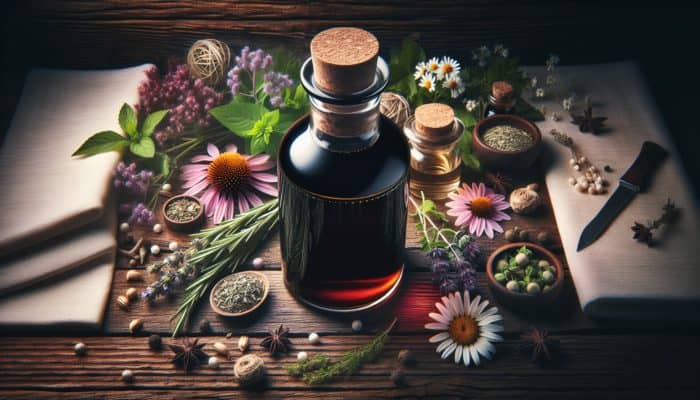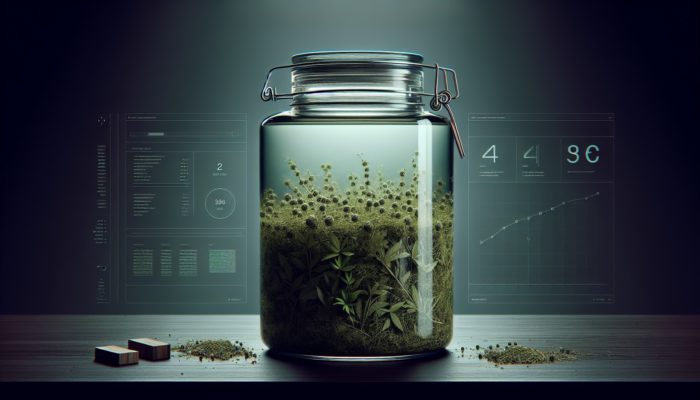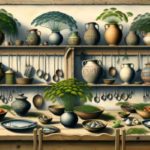Discover the Transformative Healing Properties of Herbal Tinctures
Delving into the Fundamentals of Herbal Tinctures

Engaging in DIY Herbal Tincture Recipes introduces you to the world of herbal tinctures, which are concentrated liquid extracts derived from a variety of herbs, renowned for their remarkable medicinal benefits. The meticulous process of crafting these tinctures involves soaking herbs in a solvent, typically alcohol or vinegar, which effectively extracts the active compounds found in the herbs. This extraction method not only preserves the essential characteristics of the herbs but also produces a potent product that can be easily consumed or incorporated into other natural remedies. In the UK, there are numerous herbs that are frequently utilised in tinctures, including:
- nettle
- Elderberry
- Chamomile
- Thyme
- Lavender
- Milk Thistle
- Rosemary
- Peppermint
Revealing the Profound Benefits of Herbal Tinctures
Embracing the therapeutic potential of tinctures offers a multitude of advantages for those in search of natural remedies. A significant benefit of tinctures is their rapid absorption, as the alcohol or vinegar base facilitates faster entry into the bloodstream than other herbal forms. Moreover, tinctures are well-known for their long shelf life, often remaining potent for several years when stored correctly. Their concentrated nature means that only a minute quantity is required for effective dosing, making them both cost-effective and convenient. Additionally, tinctures can be easily blended with various liquids, enhancing the versatility of consumption methods. Key benefits encompass:
- Rapid and effective absorption
- Extended shelf life when stored appropriately
- Flexibility in dosing and methods of consumption
- Cost-effectiveness owing to concentrated formulations
Essential Safety Considerations When Using Tinctures
Although tinctures are generally regarded as safe for most individuals, it is crucial to take certain precautions prior to use. Identifying possible interactions with pharmaceutical medications is vital, particularly for those on long-term treatment plans. Responsible usage necessitates an understanding of the unique characteristics of each herb and any associated contraindications. It is always wise to consult a healthcare professional before embarking on any new herbal regimen, especially for pregnant or nursing individuals, or those with pre-existing health conditions. Important safety considerations include:
- Consult a healthcare provider before use.
- Stay informed about potential interactions with medications
- Begin with small doses to evaluate tolerance
- Store tinctures in a cool, dark environment to prevent degradation
Your Comprehensive Guide to Creating Herbal Tinctures at Home

Crafting your herbal tinctures at home is not only straightforward but also an empowering experience that allows you to customise remedies tailored to your unique health needs. Begin by selecting high-quality, organic herbs alongside an appropriate solvent, such as high-proof alcohol or vinegar. The conventional method involves finely chopping the herbs and placing them in a sterilised jar, ensuring they are fully immersed in the solvent. Seal the jar tightly and store it in a cool, dark location for several weeks, gently shaking it every few days to promote extraction. Once the steeping process is complete, strain the mixture through a fine mesh or cheesecloth to yield the liquid tincture. This simple yet effective approach enables you to harness the health benefits of herbs while creating tinctures specifically aligned with your health conditions and personal preferences.
Proven Techniques for Crafting Your Own Herbal Tincture Recipes
Professional Tips for Formulating Potent Tinctures
Experts in the field of herbal medicine recommend several best practices for creating effective tinctures that maximise potency and efficacy. One essential suggestion is to use high-proof alcohol, as it extracts a broader range of plant compounds compared to lower concentrations. Fresh, organic herbs are ideal for their enhanced medicinal properties; however, dried herbs can also be employed with adjusted dosages. The optimal herb-to-alcohol ratio is typically 1:5 for dried herbs and 1:2 for fresh herbs, ensuring that the mixture retains its potency.
Follow these actionable steps to create your tincture:
1. Select and prepare your herbs: Clean and chop fresh herbs or measure dried herbs based on the desired ratio.
2. Combine herbs and solvent: Place the herbs in a clean glass jar and completely cover them with alcohol, ensuring they are fully submerged.
3. Seal and store: Secure the jar tightly and position it in a dark, cool area for 4 to 6 weeks, gently shaking every few days.
4. Strain and bottle: After the steeping period, strain the liquid using cheesecloth or a fine mesh strainer, and transfer it to a dark glass bottle for storage.
Discovering the Most Effective Herbs for Tinctures

In the UK, a variety of herbs are recognised for their effectiveness in tincturing, attributed to their therapeutic properties and cultural importance. Nettle is celebrated for its anti-inflammatory effects and is frequently used to alleviate allergies and joint pain. Elderberry is highly regarded for its immune-boosting properties, especially during the colder months when colds and flu are prevalent. Chamomile, a cornerstone of UK herbalism, is revered for its calming effects, making it an excellent choice for promoting relaxation and restful sleep.
A potent nettle tincture recipe includes using fresh leaves, soaking them in high-proof alcohol for six weeks, and then straining to create a concentrated extract. Elderberry tinctures can be made by combining fresh elderberries with vodka or brandy, crafting a remedy that supports immune health. Chamomile tinctures can be created using dried flowers steeped in alcohol to produce a soothing liquid that enhances sleep quality when taken before bedtime.
Best Practices for Storing and Preserving Tinctures
Appropriate storage and preservation techniques are vital for maintaining the potency and quality of your tinctures. Tinctures should be stored in dark glass bottles to shield them from light exposure, which can degrade the herbal compounds over time. An ideal storage location is a cool, dark area, such as a cupboard or pantry, as heat can adversely affect their efficacy.
It is advisable to label each tincture with its preparation date and contents to ensure safe usage. Regularly checking your tinctures to ensure they remain sealed and uncontaminated is crucial. By adhering to these expert storage practices, you can significantly extend the shelf life of your tinctures, allowing you to benefit from their properties for many years.
Essential Herbs for Tinctures in the UK
Unveiling the Health Benefits of Nettle Tincture
Nettle, commonly found in gardens and wild areas throughout the UK, is renowned for its anti-inflammatory properties. Traditionally, this herb has been utilised to alleviate symptoms associated with allergies, particularly hay fever, and to relieve joint pain, making it a popular choice for individuals seeking natural remedies. The high concentrations of vitamins and minerals present in nettle contribute to its health benefits, including support for kidney function and an overall boost in vitality.
In UK herbalism, nettle is often prepared as a tincture due to its concentrated nature, allowing for effective dosing without the need for large quantities. When consumed in tincture form, nettle may assist in alleviating seasonal allergies, potentially reducing reliance on pharmaceutical antihistamines. Furthermore, many herbalists recommend incorporating nettle tincture into a daily routine to enhance overall health, particularly in spring when pollen levels rise.
Exploring the Common Uses of Elderberry Tincture
Elderberry is a highly esteemed herb in the UK, particularly noted for its immune-boosting capabilities. Traditionally, elderberry tincture is employed during the cold and flu season to fortify the body's natural defences against viral infections. The berries are rich in antioxidants and have been shown to shorten the duration of colds and flu when taken at the onset of symptoms.
In practical application, elderberry tincture can be mixed into warm water for a comforting drink or added to herbal teas to enhance immune support. Some individuals opt to take it daily throughout the winter months as a preventative measure, while others use it acutely when symptoms arise. The versatility and effectiveness of elderberry tincture make it a staple in many herbalist practices across the UK.
Utilising Chamomile Tincture for Enhanced Calm and Relaxation
Chamomile is widely recognised for its tranquilising effects and is frequently utilised in tincture form to promote restful sleep and alleviate anxiety. This popular herb boasts a rich history in UK herbalism, where it is valued for its gentle sedative properties. To optimise its relaxing effects, chamomile tincture can be taken before bedtime or during stressful moments throughout the day.
This tincture can be easily integrated into a calming evening routine, perhaps mixed into a warm cup of milk or herbal tea for added relaxation. Additionally, chamomile tincture can be applied topically to soothe skin irritations or reduce tension headaches. Its versatile applications render chamomile a favourite choice among herbal enthusiasts seeking natural solutions for daily stress and sleep disturbances.
Essential Guidelines for Crafting Tinctures at Home
Key Considerations When Selecting Herbs for Tinctures
Choosing the right herbs for your tinctures is the foundational step in creating effective remedies. The selection of herbs should align with the health benefits you aim to achieve; for instance, opt for chamomile for relaxation or nettle for alleviating allergies. Freshness and quality are paramount—always select organic herbs when possible, as they are less likely to be tainted with pesticides or harmful substances.
For those new to tincture-making, herbs like peppermint, chamomile, and lavender are excellent choices due to their availability and ease of preparation. These herbs yield effective tinctures and serve multiple purposes, from enhancing digestion to promoting restful sleep. By thoughtfully curating your herb selection, you can create tinctures specifically tailored to your health needs and individual preferences.
Effective Techniques for Preparing Herbs for Tincturing
Proper preparation of herbs is essential for maximising the extraction of their beneficial compounds during the tincture-making process. Begin by thoroughly cleaning the herbs to eliminate any dirt or contaminants. For fresh herbs, gently rinse them under cool water and pat them dry with a clean towel.
Chopping the herbs into smaller pieces increases their surface area, facilitating better extraction of active ingredients. In certain instances, especially with dried herbs, lightly crushing them can further enhance the potency of the tincture. It is also important to acknowledge that some herbs may require drying before tincturing, as moisture can dilute the alcohol and impede extraction efficiency. By concentrating on the preparation process, you ensure that your tinctures are as effective as possible.
Understanding the Steps Involved in the Tincturing Process
The tincturing process itself is a harmonious blend of art and science, requiring precision and patience. Once your herbs are prepared, place them in a clean, sterilised jar and completely cover them with your chosen solvent, typically high-proof alcohol. Secure the lid tightly and store the jar in a dark, cool location, allowing the mixture to steep for several weeks.
During the steeping phase, it is vital to gently shake the jar every few days to encourage the extraction process. The ideal steeping duration can differ based on the herb used; generally, fresh herbs benefit from soaking for 4 to 6 weeks, while dried herbs may steep for 6 to 8 weeks. After the recommended steeping period, strain the mixture to separate the liquid tincture from the plant material, ensuring that you capture all the potent extracts. This meticulous approach culminates in a powerful herbal remedy ready for your use.
Evidence-Based Insights into the Benefits of DIY Herbal Tincture Recipes
Scientific Perspectives on the Efficacy of Tinctures
Research highlights that tinctures are an effective method for delivering herbal compounds, supporting various health benefits. Studies often focus on specific herbs and their unique actions within the body. For instance, elderberry has been documented to exhibit antiviral properties, and its effectiveness in reducing the duration of influenza symptoms aligns with its traditional applications in herbal medicine.
Moreover, an expanding pool of evidence supports the idea that tinctures, due to their concentrated nature, can provide higher doses of beneficial compounds compared to other herbal forms, such as teas or capsules. This makes tinctures a particularly potent option for individuals looking to harness the full potential of herbal remedies in a convenient form. As the interest in natural and holistic health continues to grow, scientific exploration into tinctures is likely to expand, further validating their role in contemporary herbalism.
Comparative Advantages of Tinctures Over Other Herbal Forms
Tinctures present distinct advantages over traditional herbal forms like teas and capsules, primarily in terms of absorption and convenience. Unlike teas, which require hot water to extract active compounds and can be time-consuming to prepare, tinctures are ready for immediate use and provide a concentrated dose with just a few drops. Capsules, while practical, may not always ensure complete absorption of herbal constituents, as stomach acidity can influence their efficacy.
For individuals contemplating their options between herbal forms, tinctures can be particularly advantageous for those who struggle with digestion or seek rapid effects from their herbal remedies. Ultimately, the choice depends on personal preference, lifestyle, and specific health needs. Maintaining a comprehensive understanding of the advantages and potential drawbacks of each form can assist in making informed decisions regarding herbal remedies.
Potential Side Effects and Important Precautions
While tinctures are generally considered safe for many individuals, it is essential to be aware of potential side effects or interactions with medications. Some herbs may trigger allergic reactions, particularly in those sensitive to specific plant families. Additionally, certain tinctures may interact with pharmaceuticals, potentially affecting their efficacy or leading to adverse effects.
To effectively manage potential side effects, it is advisable to begin with small doses and closely monitor any reactions that may occur. Keeping a journal of your tincture experiences can help identify patterns related to side effects and allow for dosage adjustments as necessary. By remaining informed and proactive, you can enjoy the benefits of tinctures while minimising any associated risks.
Ensuring the Quality of Your DIY Tinctures
Maintaining the quality of your DIY tinctures is essential for both safety and effectiveness. Start by selecting high-quality, organic herbs renowned for their potency. Accurate measurements of both herbs and solvents are vital for creating an effective tincture, as incorrect ratios can yield weak or overly concentrated products.
Proper storage is another key factor; tinctures should be stored in dark glass bottles to shield them from light and ideally kept in a cool, dark environment. Regularly inspecting your tinctures for signs of spoilage or degradation can ensure that you only use effective remedies. By following these quality assurance practices, you can trust in the tinctures you create at home.
Where to Source Premium Quality Herbs in the UK
The Benefits of Shopping at Local Health Food Stores
Local health food stores in the UK often provide a diverse selection of herbs suitable for tincturing, many sourced from local suppliers. These establishments typically offer high-quality, organic herbs, making them a reliable option for those interested in crafting their tinctures. When shopping at health food stores, it is advisable to inquire about the origins of the herbs to ensure their quality and sustainability.
Moreover, local health food stores frequently feature knowledgeable staff who can offer valuable insights into the best herbs for specific ailments, further assisting you in your tincture-making endeavours. Supporting local businesses not only benefits your health but also contributes to the community and promotes sustainable practices within the herbal industry.
The Advantages of Sourcing Herbs from Online Suppliers
The convenience of online shopping has revolutionised the process of sourcing herbs for tinctures in the UK. Numerous reputable online suppliers offer an extensive range of herbs, complete with detailed information regarding their origin, quality, and intended uses. Websites specialising in herbal products often feature customer reviews, enabling you to make informed choices when selecting herbs.
When choosing an online supplier, prioritise those emphasising organic and sustainably sourced herbs. Furthermore, verifying certifications or third-party testing can provide additional assurance of the quality of the products you purchase. Trusted online suppliers not only save you time but can also provide access to unique herbs that may not be available locally.
The Rewards of Foraging for Herbs in the UK Countryside
Foraging for wild herbs in the UK countryside can be a fulfilling experience, allowing you to connect with nature while sourcing fresh herbs for tinctures and other herbal remedies. Common foraging targets include nettle, elderberry, and dandelion. However, it is essential to educate yourself on foraging laws and sustainable practices to ensure that your activities are both legal and ecologically responsible.
Before embarking on a foraging adventure, familiarise yourself with specific plant species and their habitats, along with any potential look-alikes that may be toxic. Foragers should respect local guidelines regarding land access and conservation efforts. Engaging in responsible foraging not only provides fresh herbs but also fosters biodiversity and encourages a deeper appreciation for the natural environment.
Effective Strategies for Using and Dosing Tinctures
Mastering the Art of Tincture Dosing
Effectively dosing tinctures requires consideration of various factors, including the specific herb used, the tincture's strength, and individual health requirements. Generally, it is recommended to start with a small dose, such as 1 to 2 dropperfuls, and observe how your body responds before gradually increasing the amount.
Indicators of proper dosing may include the alleviation of targeted symptoms without the onset of adverse reactions. Keeping a record of your dosing experiences can enhance your understanding of how your body responds and refine your approach over time. Personalising your dosage based on your body's responses is a vital step in utilising tinctures effectively.
Innovative Ways to Incorporate Tinctures into Your Daily Life
Integrating tinctures into your daily routine can be both enjoyable and straightforward. Tinctures can be added to various liquids, such as water, juice, or herbal tea, providing flexibility in consumption. This adaptability allows you to seamlessly incorporate tinctures into your lifestyle, whether as a morning tonic or an evening relaxation aid.
Furthermore, tinctures can be creatively utilised in cooking and baking, enhancing dishes with their herbal benefits. For example, a few drops of chamomile tincture can be added to dessert recipes for a calming effect, while elderberry tincture can be mixed into homemade syrups or sauces for an immune-boosting addition. By exploring innovative ways to incorporate tinctures into your meals, you can enjoy their benefits while elevating your culinary experience.
Tracking and Adapting Your Tincture Usage
Monitoring your tincture use and its effects is an invaluable practice that allows for the optimisation of your herbal regimen. Keeping a journal can help you log dosages, frequency, and any notable changes in symptoms or overall well-being. This information can be crucial in identifying patterns and making informed adjustments to your tincture use.
When using tinctures regularly, be open to modifying your approach based on how you feel. This may involve adjusting the dosage, switching herbs, or changing the time of day you take your tinctures. By actively monitoring your experiences, you can tailor your herbal use to align with your evolving health needs and ensure you’re maximising the benefits of your tinctures.
Frequently Asked Questions About Tinctures
Which Type of Alcohol Is Best for Crafting Tinctures?
High-proof alcohol, such as vodka or brandy with an alcohol content of at least 40%, is optimal for tinctures as it effectively extracts the active compounds from herbs.
What Is the Shelf Life of Homemade Tinctures?
When stored correctly in dark glass bottles in a cool, dark place, homemade tinctures can last for several years, maintaining their potency throughout.
Can Tinctures Be Consumed in Large Quantities?
It's advisable to start with small doses and gradually increase as needed. Taking large amounts may lead to adverse effects, depending on the specific herb.
Are Tinctures Safe for Children?
Tinctures may not be suitable for children due to their alcohol content. Always consult a healthcare provider before administering tinctures to children.
How Can I Determine if a Tincture Is Effective?
You can assess a tincture's effectiveness by observing any changes in symptoms or overall health following its use, provided that proper dosing is adhered to.
Is It Possible to Combine Different Tinctures?
Yes, you can mix different tinctures, but it’s essential to understand the properties of each herb to ensure they complement each other and avoid adverse effects.
Do Tinctures Need Refrigeration?
Tinctures do not require refrigeration; storing them in a cool, dark place is sufficient for preserving their quality over time.
What Is the Best Method for Taking Tinctures?
Tinctures can be taken directly or added to water, juice, or tea for an enjoyable experience. Consuming them on an empty stomach can enhance absorption.
Can I Use Dried Herbs Instead of Fresh for Tinctures?
Yes, dried herbs can be used for tinctures, but the herb-to-alcohol ratio typically differs, often requiring more dried herbs than fresh.
What Should I Do If I Experience Side Effects from a Tincture?
If you experience side effects from a tincture, discontinue use immediately and consult a healthcare provider for guidance on managing reactions.
Connect with us on Facebook!
The Article: DIY Herbal Tincture Recipes: UK’s Natural Remedies appeared first on https://mcrtherapies.co.uk
The Article Herbal Tincture Recipes: Discover the UK’s Natural Remedies Was Found On https://limitsofstrategy.com

